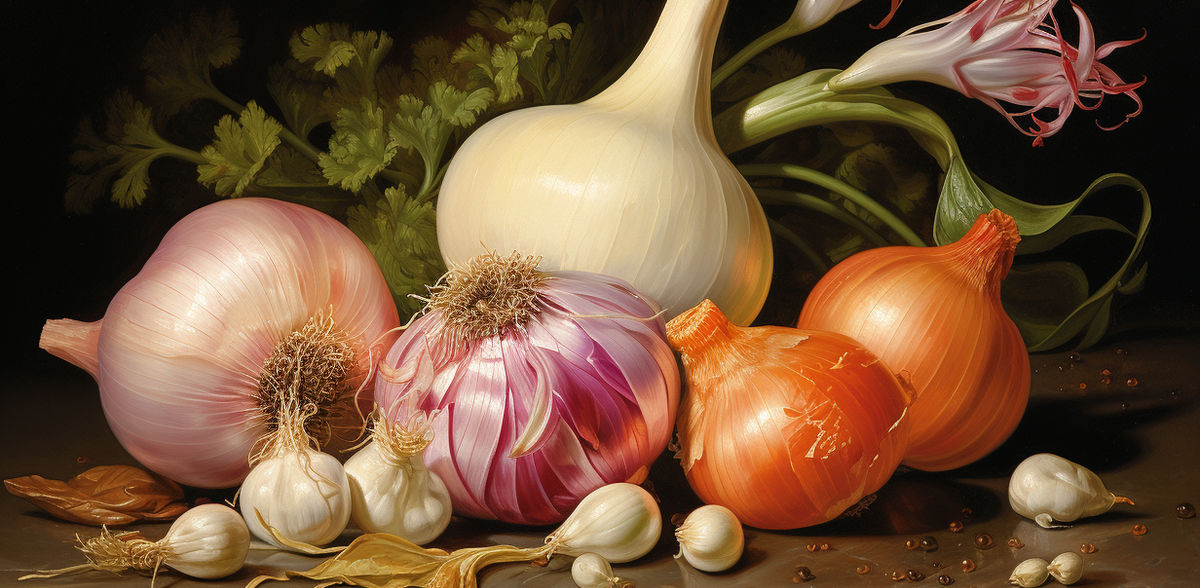Scientists name top five foods rich in prebiotics
Eating more of these foods could benefit your gut microbiome
There is growing evidence that consuming prebiotics — certain types of fiber often found in plants that stimulate beneficial bacteria in your gut — can help to maintain a healthy gut microbiome. In a new study, scientists estimated the prebiotic content of thousands of food types by using preexisting literature to find out which foods offer the highest prebiotic content.

Researcher Cassandra Boyd holding garlic and onion, two foods that the study revealed to be dense in prebiotics.
Cassandra Boyd
According to the study, foods that pack the greatest prebiotic punch are dandelion greens, Jerusalem artichokes, garlic, leeks, and onions. In addition to supporting gut microbes, prebiotic rich foods contain high amounts of fiber — something most Americans do not get enough of.
“Eating prebiotic dense foods has been indicated by previous research to benefit health,” said Cassandra Boyd, a master’s student at San José State University who conducted the research with Assistant Professor John Gieng, PhD. “Eating in a way to promote microbiome wellness while eating more fiber may be more attainable and accessible than you think.”
Boyd will present the findings at NUTRITION 2023, the flagship annual meeting of the American Society for Nutrition held July 22–25 in Boston.
Prebiotics, which can be thought of as food for the microbiome, are different from probiotics, which contain live microorganisms. Both can potentially benefit microbiome health, but they work in different ways.
Studies have linked higher prebiotic intake with improved blood glucose regulation, better absorption of minerals like calcium, and markers of improved digestive and immune function. Although most dietary guidelines do not currently specify a recommended daily allowance for prebiotics, the International Scientific Association for Probiotics and Prebiotics — a non-profit scientific organization that established the currently held definition of prebiotics — recommends an intake of 5 grams per day.
For the study, researchers used previously published scientific findings to analyze the prebiotic content of 8,690 foods contained in the Food and Nutrient Database for Dietary Studies, a resource many scientists use to study nutrition and health.
About 37% of the foods in the database were found to contain prebiotics. Dandelion greens, Jerusalem artichoke, garlic, leeks, and onions had the greatest amounts, ranging from about 100-240 milligrams of prebiotics per gram of food (mg/g). Other prebiotic rich foods included onion rings, creamed onions, cowpeas, asparagus, and Kellogg's All-Bran cereal, each containing around 50-60 mg/g.
“The findings from our preliminary literature review suggest that onions and related foods contain multiple forms of prebiotics, leading to a larger total prebiotic content,” said Boyd. “Multiple forms of onions and related foods appear in a variety of dishes as both flavoring and main ingredients. These foods are commonly consumed by Americans and thus would be a feasible target for people to increase their prebiotic consumption.”
Based on the team’s findings, Boyd said a person would need to consume approximately half of a small (4-ounce) onion to get 5 grams of prebiotics.
Wheat-containing items rank lower on the list. Foods with little or no prebiotic content include dairy products, eggs, oils, and meats.
The researchers hope the study will provide a basis to help other scientists assess the health impacts of prebiotics and inform future dietary guidelines. They noted that more research is needed to understand how cooking impacts prebiotic content and to better assess foods that contain multiple ingredients.
Most read news
Other news from the department science

Get the food & beverage industry in your inbox
By submitting this form you agree that LUMITOS AG will send you the newsletter(s) selected above by email. Your data will not be passed on to third parties. Your data will be stored and processed in accordance with our data protection regulations. LUMITOS may contact you by email for the purpose of advertising or market and opinion surveys. You can revoke your consent at any time without giving reasons to LUMITOS AG, Ernst-Augustin-Str. 2, 12489 Berlin, Germany or by e-mail at revoke@lumitos.com with effect for the future. In addition, each email contains a link to unsubscribe from the corresponding newsletter.






























































